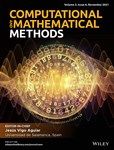Invariant measure for continuous open chain of contours with discrete time
Abstract
A dynamical system is studied. This system belongs to the class of contour networks introduced by A.P. Buslaev. The system is a version of the system called an open chain of contours. Continuous and discrete versions of the system were considered earlier. The system contains N contours. There is one adjacent contour for the utmost left and the utmost right contour, and there are two adjacent contours for any other contour. There is a common point of any two adjacent contours. This point is called a node. There is a cluster in each contour. For the continuous version, the cluster is a segment, moving with constant velocity if there is no delay. For the discrete version, the cluster is a group of adjacent particles. Delays are due to that two clusters may not move through the same node simultaneously. The main system characteristic, studied earlier, is the average velocity of clusters. In this paper, the continious and discrete version of the open chain of contours are considered. The following version of the system is also considered. Each cluster is a segment, and the cluster is shifted onto the distance α at any discrete moment if no delay occurs. We have obtained the limit distribution of the system states. We have also obtained the limit state distribution (invariant measure) for the open chain of contours with continuous state space and continuos time and for the open chain of contours with discrete state space and discrete time.
1 INTRODUCTION
In a class of transport models, the traffic is modeled by the movement of particles on a cellular field. These models may be interpreted in terms of cellular automata1 or exclusive processes.2 For simple cases, analytical results are obtained in References 3-9. The behavior of a model of this type is an asymmetrical simple exclusive process. In the models, considered in these articles, the particles move on a closed or infinite one-dimensional lattice. The article10 studies a one-dimensional model, which is a dynamical system with a continuous state space and discrete time. In particular cases, the system behavior is identical with the behavior of the models considered in References 3-6. In Reference 10 an exclusive process with discrete time is called synchronous, and an exclusive process with continuous time is called asynchronous.
The article11 studies a one-dimensional traffic model with particles of different types. In this model, particles can move forward and backward. In Reference 11, a version with discrete time and a version with continuous time are considered. The behavior of the version with discrete time is a synchronous exclusive process (in terms of Reference 10). The behavior of the version with continuous time is an asynchronous exclusive process. In Reference 11, the discrete time model is interpreted as a discrete time queuing network as in Reference 7, and the continuous time model is interpreted as a continuous time queuing network, Figure 1. Formulas for the average velocity of particles are obtained. The traffic models, considered in Reference 11, can be used with the deterministic-stochastic approach to traffic modeling. The deterministic-stochastic approach was introduced in References 12, 13.

A model with movement of particles on a two-dimensional toroidal lattice was studied in References 14, 15.
In Reference 16 stability conditions for a controlled dynamical system were obtained. In Reference 17 a continuous dynamical system obtained by considering the discrete original model in continuous time. While the dynamics of the continuous model is trivial, it is possible to recover the complexity of the discrete model by the introduction of time delays. In particular, high period limit cycles and chaotic attractors are observed.
The concepts of cluster movement and contour network were introduced by Buslaev.18, 19 This concept was introduced to obtain analytical results for traffic models with network structure. There may be also other applications of contour networks. For example, the concept of contour networks can be used to analyse communications systems. In a discrete traffic model with cluster movement, particles, located in adjacent cells, form clusters, and the particles of the same cluster move simultaneously. In a continuous version, a cluster is a segment moving with constant velocity, Figure 2.
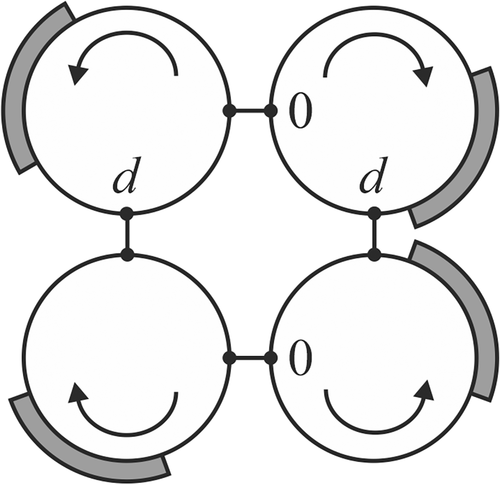
A contour network contains a system of contours. There are common points of adjacent contours called nodes. In contours, particles or clusters move. Delays occur at the nodes. These delays are due to that no more than one particle (cluster) can pass through the same node simultaneously. The movement of particles on a contour is deterministic but the rule under which particles pass through the node can be stochastic. The stochastic movement can become deterministic from a moment if from this moment no delays occur. The main characteristic of contour system is the average velocity taking into account the delays. In References 19-34 , the limit cycles and values of average velocities, depending of the initial state of the system, are obtained for some deterministic systems with two contours and contour networks with regular structures. For the contour networks that were considered in References 19-34, both the state space and time scale are discrete, both the state space and time scale are continuous. States of a deterministic discrete contour network are repeated from a moment. Thus a limit cycle of the dynamical system is realized. If the length of each contour of a deterministic continuous contour network is the same, then the invariant state sets of the system are also limit cycles. An important problem is to find the set of limit cycles.
In Reference 21, a dynamical system called a closed chain of contours (or necklace) is introduced. The closed chain of contours is a dynamical system with a one-dimensional structure, Figures 3 and 4. There are two adjacent contours for any contour of the closed chain of contours. One of the adjacent contours is located on the left, and the other adjacent contour is located on the right. There is a common node for any two adjacent contours. If two particles try to move through a node simultaneously, then a competition occurs and only one of the competing particles moves at present moment. Closed chains with different resolution rules are studied in References 19, 21, 25, 26, 29, 30. In Reference 19, the continuous and discrete versions were introduced. In the discrete version the nodes are located between cells. In References 19, 21, 26, 29, analytical results for the discrete version are obtained. In particular, in References 19, 21, 29, analytical results are obtained under the assumption that there are two cells and a particle in any contour (a binary chain). In Reference 25, analytical results for the continuous version of closed chain of contours are obtained.
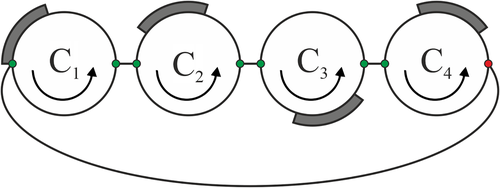
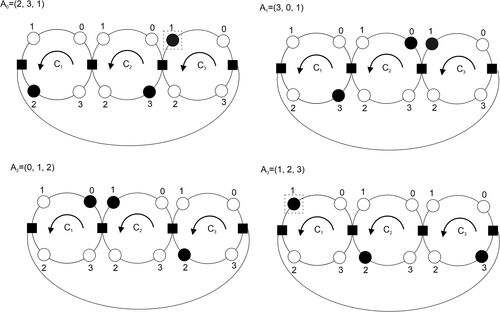
In References 27, 28, a dynamical system called an open chain of contours is considered. In this system, the utmost left or the utmost right contour has a node such that this node is common for this contour and the adjacent contour. There are two adjacent contours and two nodes for any other contour. In Reference 27, the continuous version of open chain of contours is studied, and, in Reference 28, the discrete version is studied. In References 27, 28, the limits cycles and values of the average velocity are obtained.
In Reference 19, a dynamical system with two-dimensional toroidal structure is also introduced. This system is called a chainmail. There are four adjacent contours for each contour of chainmail. In Reference 20, the chainmail is studied under the assumption that there are four cells and a particle in any contour of chainmail. There are four adjacent contours for any contour of chainmail. Any cell is combined with the node which is common for two contours. Analytical results for this system were obtained in Reference 22. A version of the chainmail with rectangular structure (open chainmail) was also considered.
Some contours networks with two-dimensional honeycomb structure were studied in Reference 22, Figure 5.
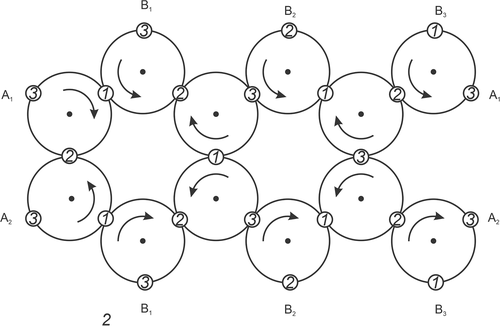
The article24 studies different discrete versions of the contour network with two contours and a common node (two-contours system). In the system, the particles move under rules similar to the rules of the elementary cellular automaton 184 or 240. The rule 240 corresponds to the cluster movement in a discrete contour network. The article32 considers a continuous two-contours with contours of different lengths, Figures 6 and 7. Some concepts and theorems of the number theory are used to analyse this system. If the ratio of the contours is a rational number, then limit cycles are realized. If the ratio of the contours is an irrational number, then the invariant state space of the system is a spectral cycle only if the system does not result in a state of free movement. The article31 studies a contour network with two contours and two common nodes is studied, Figure 8. The article33 studies a contour network with two contours of different lengths and one common node. It is assumed in Reference 33 that the particles move under the rule similar to the rule similar to the rule of the elementary cellular automaton 184.
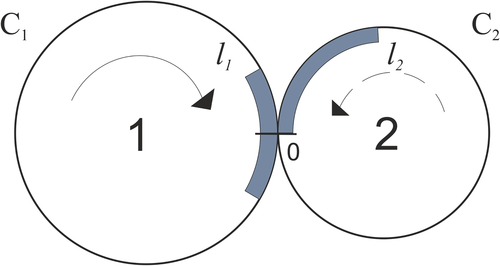
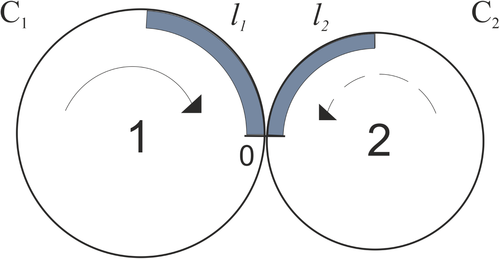
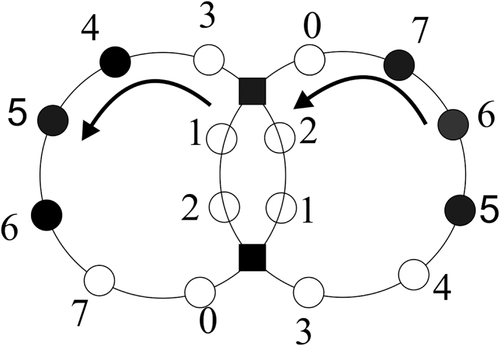
In References 35-37 dynamical systems similar to the contour networks are considered. In Reference 35, some dynamical systems are considered which can be interpreted as follows. There is a set of vertices. At discrete moment, each vertex can send messages to other vertices through channels connecting the vertices. The vertices send the messages under a prescribed plan. Delays in the transmission of messages are due to that no more than one message can be transmitted simultaneously through the same channel. In particular cases, the behavior of the system can be represented by the same process as a related contour network. In Reference 35, a stochastic version is introduced for a system of this type. If the system is in the state such that, in the deterministic version, a message is transmitted (or a particle moves), then the probability that, in the stochastic version, the message is transmitted (the particle moves) is where is a small value. The asymptotic behavior of the system as is studied.
The articles36-38 study dynamical systems such that particles move in channels of these system under prescribed plans. In particular, a dynamical system called a bipendulum is studied, Figure 9. The bipendulum contains two vertices. The vertices send messages to each other through channel under a prescribed plan. The plan of a particle is prescribed by the sequence of digits in the binary representation of a real number. Delays in the plan realization are due to that particles cannot move through the channel in the opposite directions simultaneously. If the particles try to move in the opposite directions simultaneously, then a competition occurs, and only the particle winning the competition moves at the present moment. Each of two competing particles wins the competition equiprobably. A Markov chain is related to the system. If the plans of the particles are prescribed by rational numbers, then there exist the stationary probabilities of this Markov chain. Some algebraic concepts and classical theorems of the number theory are used to analyse the behavior of bipendulum. In Reference 36, a class of unary algebras is introduced for analysing the bipendulum. These algebras are defined on the set of the rational numbers belonging to the segment There is a unique unary operation in a algebra of this type. This operation is called the Bernoulli shift. Therefore these algebras are called the Bernoulli algebras. The article37 studies a generalization of the bipendulum called a real valued pendulum, Figure 10. The system is developed for modeling of particles relocations on abstract graph with formalized rules of behavior (competition for space) and movement plans logistics. Logistics is given in a formal statement by the real numbers of the unit closed interval, presented in calculus with base equals to the graph power
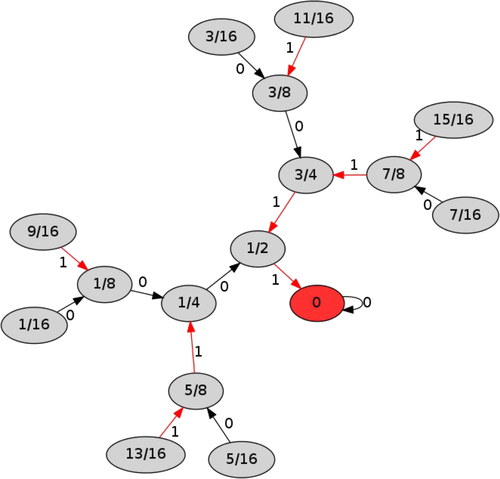
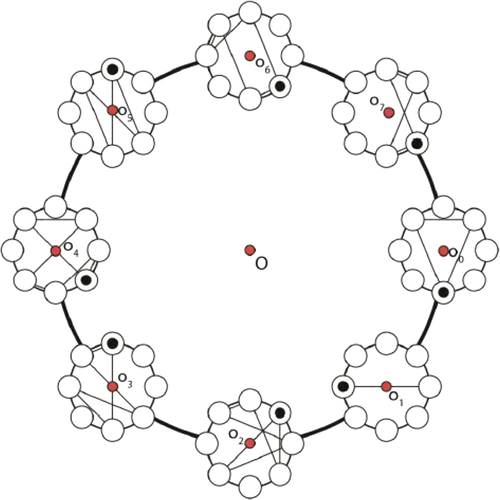
The main problem is to study the behavior of the pendulum depending on its architecture.
A generalization of the class of Bernoulli algebras can be used for analysing the real-valued pendulum. This generalization is studied in Reference 39. The article38 also studies some other dynamical systems similar to the real-valued pendulum, in particular, the system called a chaotic pendulum.
An open chain of the contours with continuous state space and discrete time is introduced in this article. The limit state distribution of this system is obtained. This system is a generalization of a dynamical system called circumference shifts, which was considered in Reference 40.
2 THE SYSTEM WITH CONTINUOUS STATE SPACE AND CONTINUOUS TIME
Let a dynamical system contain N circumferences (contours) Figure 11. The coordinate system is defined on each circumference. There is a common point of the circumferences i and This point is called the node The coordinate of the node equals 0 for the circumference and the coordinate of the node equals for the circumference There is a segment, called a cluster on each circumference. The length of the cluster equals A state of the system is the vector where is the coordinate of the leading point of the cluster, located on the circumference (cluster We say that the cluster i occupies the node if We say that the cluster i occupies the node if and, for also if The state of the system is admissible if no node is occupied by more than one cluster. The initial state, that is, the state of the system at time is prescribed. Let be the set of admissible states. At any time, each cluster moves with the velocity 1 if there is no delay. The delay of a cluster occurs if this cluster is at the node occupied by the cluster of the adjacent contour. If the clusters i and come to the node simultaneously, then the cluster i passes through the node first. This system is called the system

The system state at time t is the N-tuple where is the coordinate of the leading point of the cluster i at this time,
Let an arc be defined on any circle. Denote by the arc located on the circumference Let be the Cartesian product of the arcs. Denote by the total time in the interval such that during this time the system is in states of the set for the initial state
Theorem 1.For any initial state, the limit density is not equal to 0 if and only if, there exist such that
Proof.In accordance with results obtained in Reference 27 , from any initial state, the system results in the state and, further, the system states are repeated with period
Suppose, at the system is in the state Let us consider the behavior of the system in time interval In the time interval only the cluster N moves. The cluster begins to move at time and ends to move at time At time the system results in the state Hence, the following is true.
Suppose
Suppose, at time the system is in the state Suppose
3 SYSTEM WITH CONTINUOUS STATE SPACE AND DISCRETE TIME
Theorem 2.
- (1)
Let the ratio and l be an irrational number. Then the state distribution densities for the system and the corresponding system with continuous time (we call it the system )are the same, that is, these densities correspond to Theorem 1.
- (2)
If the ratio and l is a rational number, then the limit state distribution is discrete.
Proof.In Reference 40, a dynamical system, which we call the system is considered. The set of the system states is The initial state is prescribed. The system state at time is
In Reference 1 it has been proved that, if the number is irrational, then the limit state distribution of the system is uniform.
Suppose that, at the initial moment the systems and are in the same state. It follows from the results of Reference 20, for the system there exist such that, at time the system is in a state belonging to a periodic orbit (limit cycle) with period
Let be the set of system states such that the system is in the state in time interval greater than t and less than time units. Suppose
Analogously, we define the value as the part of time such that during this time the system is in the states of the set , and we define the value as the part of time such that, during this time, the system is in the states, belonging to the set It is evident that
The second statement of the theorem follows from that, as it has been proved in Reference 1,
4 CONCLUSION
The article considers two versions of a dynamical system called an open chain of contours which belongs to a class of Buslaev contour networks. The contour networks were developed to obtain analytical results for traffic models with network structures. The contour networks can also have other applications. Analytical results were obtained for the two-contour systems and contour networks with regular structure.
Earlier, results were obtained for contour networks with both a discrete state space and discrete time, and results were also obtained for contour networks with both a continuous state space and continuous time. Contour networks with continuous state space and discrete time were not considered. A contour system of such type is considered in this article. The article considers two versions of open chain of contours. The utmost left and the utmost right contour of an open chain has only one adjacent contour. Each of the others contours of the system has two adjacent contours.
The first considered version of the open chain is a system with a continuous state space and continuous time. The new result is that the stationary state distribution (invariant measure) has been obtained.
The second version is an open chain with a continuous state space and discrete time, which is a generalization of a dynamical system called circumference shifts, which was considered by A. Katok and B. Hasselblatt. For this version of open chain, the stationary state distribution is also obtained. This invariant measure does not depend on the initial state of the system, though, for other contour networks, for example, closed chains of contours, the invariant measure can depend on the initial state.
ACKNOWLEDGMENT
The work is supported by the Russian Foundation for Basic Research (project No. RFBR 20-01-00222)
Biographies

Marina V. Yashina is professor and a head of Higher Mathematics Department of the Moscow Automobile and Road Construction Technical University (Russia), and a professor of Mathematical Cybernetics and IT Department of the Moscow Technical University of Communications and Informatics (Russia). From 1974 till 1979 she is an undergraduate student of the Lomonosov Moscow State University, Mechanical-Mathematical Faculty (Russia). She received her PhD (Math) degree from the Lomonosov Moscow State University (Russia) in 1989, and Dr. Sc. (Tech.) from the Moscow Automobile and Road Construction Technical University (Russia) in 2000. Her research has mainly focused on dynamical systems, mathematical modeling of complex socio-technical systems, intelligent transport systems, and cybernetics.

Alexander G. Tatashev was born on February 15, 1955 in Moscow, Russia. From 1973 till 1978 he is an undergraduate student of Moscow Physical Technical Institute, Russia. From 1978 till 1995 he worked at Scientific Research Institute of Communications and Control Systems. From 1995 till present he works at Moscow Automobile and Road Technical University. From 2003, he is professor of this university. He is the author more than 100 research publications related to queuing theory, mathematical modeling, discrete dynamical systems et al.



